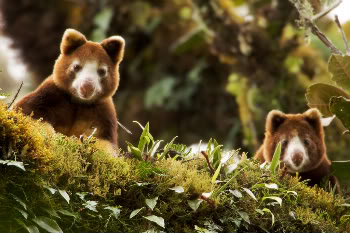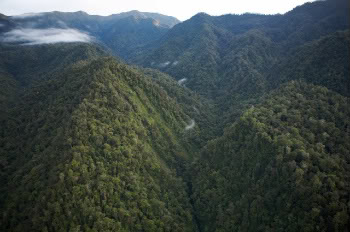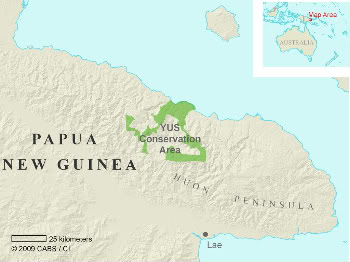Landmark agreement by 35 villages secures first first national conservation for PNG
Home to numerous endemic species and some of the Asia’s last intact tropical forests, Papua New Guinea has created its first national conservation area. Unique in structure, the park is owned by 35 surrounding indigenous villages which have agreed unanimously to prohibit hunting, logging, mining, and other development within the park. The villages have also created a community organization that will oversee management of the park.
The 10,000 villagers found partners in Woodland Park Zoo in Seattle, Conservation International, and National Geographic. The conservation organizations spent twelve years working with locals and the Papua New Guinea government to establish the YUS Conservation Area. The reserve is an acronym named after three major rivers that run through it, the Yopno, Uruwa, and Som of the Huon Peninsula.
 Two Matschie’s tree kangaroos (Dendrolagus matschiei), which is listed as an Endangered species by the IUCN, peer from a perch high in the trees of the newly created YUS Conservation Area of Papua New Guinea. Photo by: Tim Laman. |
“Creating this conservation area is a step forward for both Papua New Guinea and conservation worldwide,” said Dr. Lisa Dabek, field conservation director at Woodland Park Zoo. “What we have accomplished here is more than just an act of environmental preservation – it’s a sustainable model for community-based conservation that works.”
Dabek first came to Papua New Guinea to study the endangered Matischie’s tree kangaroo. Heading up the Tree Kangaroo Conservation Program (TKCP) out of Woodland Park Zoo, Dabek worked with locals to map the species’ habitat. Gaining the trust of local landowners, Dabek began to push forward with efforts to establish habitat protection for the tree kangaroo and other species.
All rural land in Papua New Guinea is owned by villages or landowners, not the government, which has made establishing national reserves impossible until now. Dabek convinced the villages and other landowners to set aside portions of land for conservation until they had accumulated 187,800 acres of pristine forest.
 Children in traditional dress at the 10-year celebration of the Woodland Park Zoo’s Tree Kangaroo Conservation Program in Keweng village neighboring the newly declared YUS Conservation Area in Papua New Guinea. Photo by: Jeff Backer. |
In return for their generosity, TKCP is working with the villages to increase access to education and improve community health care. TKCP will also work directly with the communities’ management organization for the YUS Conservation Area.
Stretching from the northern coast of Papua New Guinea to the western Saruwaged Mountains, the park is slightly larger than the island-nation of Dominica and home to many more vulnerable and endangered species than Matschie’s tree kangaroo, including the long-beaked echidna, New Guinea harpy eagle, New Guinea pademelon, the dwarf cassowary, and Salvadori’s teal. Two endemic species include a bird of paradise, called the Huon astrapia, and a species of honeyeater, Huon melidectes.
“By creating the country’s first national conservation area, the PNG government and people have established a much-needed safe zone for the irreplaceable biodiversity it contains,” said Dabek. “Just as important, the protected area will contribute to long-term efforts to address the climate change threat by preserving critical forest habitat.” It is estimated that the protected tropical forest stores 13 million tons of carbon.
 Aerial view of the tropical forest carpeting the newly declared YUS Conservation Area in Papua New Guinea. Photo by: Tim Laman. |
The park is an important symbol of Papua New Guinea’s commitment to conservation, since the country’s ecosystems have been devastated by deforestation. In just thirty years Papua New Guinea has lost 15 percent of its forest due to logging, according to a report appearing in Biotropica. The report, showing that Papua New Guinea was losing forest far faster than expected, astounded conservationists. In addition, the report showed that 9 percent of forests in Papua New Guinea had been degraded in the same period.
According to the International Herald Tribue the majority of the logging out of Papua New Guinea ends up in China where it is made into flooring and furniture to feed the demand for cheap wood products in America and Europe. The logging is mostly undertaken by Malaysian firms, some of which have been caught bribing government officials and underpaying local landowners.
Environmentalists hope that the YUS Conservation Area will begin a new pattern in Papua New Guinea—and around the world.
 Map of YUS Conservation Area. |
“This new conservation area shows how much good can be accomplished when governments and people work together,” said Conservation International President Russell A. Mittermeier, who visited the area last year. “Hopefully, other tropical forest nations will follow this example of simultaneously combating climate change and conserving the ecosystems on which people depend, and the international community will embrace a climate change treaty that compensates the carbon sequestration value of such protected forests.”
Conservation International and TKCP plan to keep working with the government and local communities to create more conservation areas in the country. With YUS as a model, the task may be far easier this time around.
Related articles
24% of Papua New Guinea’s rainforest destroyed or degraded by logging in 30 years
(02/22/2009)
Nearly one quarter of Papua New Guinea’s rainforests were damaged or destroyed between 1972 and 2002, report researchers writing in the journal Biotopica.
Papua New Guinea to ban log exports by 2010
(03/18/2008)
Papua New Guinea (PNG) will phase out log exports by 2010 said Forest Minister Belden Namah last month. The move comes as the country seeks to gain greater control over illegal logging and promote expansion of oil palm cultivation.
How activists and scientists saved a rainforest island from destruction for palm oil
(02/12/2008)
In mid-January, Mongabay learned that the government of Papua New Guinea had changed its mind: it would no longer allow Vitroplant Ltd. to deforest 70% of Woodlark Island for palm oil plantations. This change came about after one hundred Woodlark Islanders (out of a population of 6,000) traveled to Alotau, the capital of Milne Bay Province, to deliver a protest letter to the local government; after several articles in Mongabay and Pacific Magazine highlighted the plight of the island; after Eco-Internet held a campaign in which approximately three thousand individuals worldwide sent nearly 50,000 letters to local officials; and after an article appeared in the London Telegraph stating that due to deforestation on New Britain Island and planned deforestation on Woodlark Island, Papua New Guinea had gone from being an eco-hero to an ‘eco-zero’.
Papua New Guinea log exports to China surge
(12/19/2006)
Papua New Guinea (PNG) log exports surged in October according to the International Tropical Timber Organization’s (ITTO) Tropical Timber Market Report.














